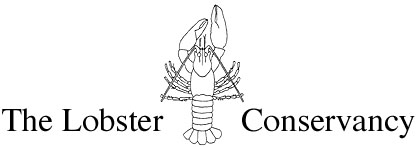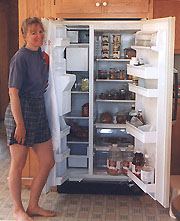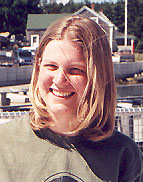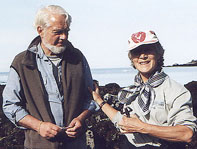
P.O. Box 235, Friendship, ME 04547 (207) 832-8224 www.lobsters.org

P.O. Box 235, Friendship, ME 04547 (207) 832-8224 www.lobsters.org
July 1, 1999
Dear Volunteers and Friends of The Lobster Conservancy,
Now that summer has kicked in, and volunteers are in full swing, we'll be back to keeping you up-to-date on a monthly basis. Here's what happened at TLC in June.News from the Board of Directors
TLC has been incredibly fortunate recently. Thanks go to Maine/New Hampshire Sea Grant for providing $1,100 to buy 7 new sets of monitoring equipment for the Penobscot Bay Intertidal Lobster Project. We are also very grateful to the Davis Conservation Foundation for awarding us a grant of $10,000 to initiate new research at the Friendship Lobster Laboratory (see details below). And we are especially thankful to an anonymous individual who donated $10,000 to convert the Friendship Lobster Laboratory from diesel power to solar power (see details below).
On June 26th TLC's Board of Directors met at the Friendship Lobster Laboratory. We discussed TLC's current status and goals, and made plans to ensure a healthy future for the organization. After an intensive and fruitful discussion, Diane and Sara led board members Adria Elskus, Tom Archambault, and Alex Loer on their first tour of our new facility on Friendship Long Island. They were duly impressed by its incredible potential for lobster research as well as the beauty of the location.
Friendship Lobster Laboratory
In June, Diane finished moving into the pound-keeper's house — thanks to the help of many! Special thanks to Linda Archambault who helped load then drive the UHaul; Kevin Benner who loaded his lobster boat and transported Diane's belongings to the island; and Keith Bisson who helped put the last load in storage.

Linda Archambault helped Diane move to the Friendship Lobster Laboratory (photo by Sara Ellis).

The wharf and pound-keeper's house at the Friendship Lobster Laboratory (photo by Sara Ellis).
 In the absence of electricity, Diane has found unconventional uses for appliances at the Friendship Lobster Laboratory (photo by Adria Elskus). |
Until now, the pound-keeper's house was powered by a noisy, pollution-prone, diesel generator . The Lobster Conservancy plans to convert the house to solar power as part of an environmental and educational program about this clean, renewable resource. Talmage Solar of Kennebunkport is designing a solar system for the site. We have already been blessed with an anonymous donation of $10,000 towards this goal, and must raise additional funding to bring this project to fruition. In the meantime, Diane is surviving without electricity or plumbing. She's found that an unwired fridge provides great shelf space!!
Several visitors have come out to the laboratory, worked on projects to get the pound and grounds ready for the business of lobster research, and offered advice. Diane is pleased to report that she has met many of the fascinating, talented and wonderful neighbors on the island — thanks to introductions by Rod Pratt (her closest neighbor). Work is progressing well. With the help of support received from the Davis Conservation Foundation, we are initiating a research project in the pound that will involve volunteers from the local community. The current plan is to construct and set up lobster habitat in the pound, produce maps and drawings of the lobster shelters, order tags and other research materials, collect the lobsters, and put them in the pound when sea water temperature begins to drop in September. The research will focus on adult lobsters of various sizes. Our objective is to study their courtship and mating behavior (as a continuation of Diane's dissertation research) while gathering data on growth — including molt interval and molt increment (critical information needed for stock assessments). |
Little Morse Island
Bob and Beverly Souer's introduced themselves as our neighbors on Little Morse Island, where TLC owns two lobster pounds and two small buildings. We have been discussing the future of the LMI lobster pounds and considering how we can work together to improve the safety and functionality of the properties. Bob and Beverly are strong supporters of both the lobster industry and the Friendship community. We are fortunate to have such endearing neighbors.
Research News
Currently, TLC has 43 volunteers monitoring 21 sites from the coast of New Hampshire, through Harpswell, to Isle au Haut in Penobscot Bay. The weather and tides have been very cooperative so far this year.
New Hampshire and Southern Maine
Alan Stewart and Bobbi Costello are continuing to monitor their site at Odiornes State Park in New Hampshire. In June they found 8 juveniles ranging from 26 to 42 mm in carapace length (CL). Not content to be mere mortals, and stick with one site, they are also scoping out other sites along the whole coast of New Hampshire. They have also hopped the border into Maine to look for new sites near Kittery. The area looks promising as they found lobsters ranging from 7 - 40 mm CL, in a range of habitats including mud. Al is also helping to recruit new volunteers within New Hampshire.
Harpswell
Lobsters were abundant at Lowell's Cove in June. Therefore, Diane was extremely fortunate to recruit three new helpers! Althea Alexander, Sarah Dennison, and Margaret Stone all assisted with haphazard sampling while Diane tagged and continued quadrat sampling. In addition to lobsters, several species of fish were found, including silver hake, brits (small herring), flounder, menhaden, and eel. The usual rock gunnels were plentiful, but, we didn't see any sculpins. Many of the lobsters in Lowell's Cove were undergoing their first molt of the season as evidenced by large limb buds, loose carapaces, soft shells, and brittle shells. Diane tagged approximately 280 lobsters, recaptured 21 and found 4 who were too small to inject with tags. The smallest lobster found at Lowell's Cove in June measured 9 mm in carapace length (less than one inch long from the tip of the tail to the tips of the claws). The largest measured 73.5 mm CL — representing a size only one molt away from being a "keeper".
Corie Bibber has entered her fourth year of monitoring intertidal lobsters with TLC. She was psyched to find 3 lobsters (10-35 mm CL) in Mackeral Cove, a site that has been quite barren since a boat sank in the harbor in the fall of1997. In Little Harbor, Corie's second site, she found 5 lobsters (23-45 mm CL).
Amy Watson has been monitoring a productive site at Cundy's Harbor for 3 years. This June, Amy found 14 lobsters (14-47 mm CL) along her transect.
For 3 years, Ned and Kathy Osolin have been studying lobsters on Jaquish Island while their daughter Krisitine, now a student at U. Maine Orono, has been monitoring Pott's Point. Jaquish yielded 12 lobsters last month (29-63 mm CL), but pickings were slim at Pott's Point, where only one lobster (45 mm CL) revealed itself.
Chris, Anna and Grace Heinig got out to their site at Gun Point in May, but were unable to survey it in June.
Friendship Long Island
After spending June 11-16 tides at Lowell's Cove, Diane spent the remaining June tides scouting around Friendship Long Island. She searched the west side of the island on June 17th, starting at the wharf of the Friendship Lobster Laboratory and continuing on until the shoreline became too steep to pass (at the Friou's house). There were a couple of lobsters hiding under clumps of mussels on the beach in front of the old pound house — near where the old schoolhouse now stands. Then, around the next corner in the next inlet, Diane found a place suitable for running a transect lines. Next month, Sara and Diane plan to establish that transect together.
Sara joined Diane on the 18th to continue surveying the west side of the island. They headed toward the north end starting at the Friendship Lobster Laboratory, continuing past the Pratt's house and on to the Loomis' wharf. Finding no lobsters along that shoreline, they hopped in the outboard and headed to the east side of Friendship Long Island where they landed at Mark Wallace's wharf. There they found several lobsters that they measured and put back. Some of these were in U-shaped burrows dug into the mud beneath clumps of large mussels.
Penobscot Bay
 Julia Dietz, a summer intern with the Island Institute, is helping out with the intertidal lobster monitoring program (photo by Sara Ellis). |
Sara finished training sessions around Penobscot Bay in June. TLC now has 30 volunteers monitoring 15 sites around the bay. Julia Dietz, a student in Environmental Studies at Bowdoin College, is an intern with the Island Institute this summer and will be helping out with TLC's Pen Bay work in many capacities, including training, communication, and data entry. Welcome aboard, Julia!
There are a few sites, mostly in the upper reaches of Pen Bay, where volunteers have not yet found any lobsters (see below). But it is important to keep in mind that knowing where juvenile lobsters are NOT is just as important as knowing where they ARE (though admittedly not as much fun!). Near Stonington, new volunteers Ken and Terry Bovee showed Sara several potential sites on the southwest side of Deer Isle, then continued to scout over the next few days. Undiscouraged by the lack of lobsters, they will continue to monitor Sand Beach next month and scout for other sites. |
 Ken and Terry Bovee are searching the coast of Deer Isle for intertidal lobsters (photo by Sara Ellis). |
Up the bay a bit in Castine, Elaine and Annie Gardner have been faithfully searching for as yet elusive lobsters. They have enjoyed seeing and learning about the other marine life that they find.
Similarly, on Islesboro, three dedicated teams of volunteers did not found any lobsters in May or June despite the presence of apparently suitable habitat. Steve and Jairus Miller have been checking out Loranus Cove on the eastern side of Islesboro, and Brackett's Channel near the southwest tip of the island. Ed and Alice Girvin and Tyne Barber have been monitoring Grindle Point on the western side of the island near the ferry terminal, while Bob Congdon and Jim Mitchell have been looking a little further north in Sprague Cove. On North Haven, teacher John Dietter has handed off his monitoring knowledge to Luke Howell, who will be working with students from the North Haven Community School over the summer. They have not yet found any lobsters at their site near the northwestern tip of the island. |
On Vinalhaven, volunteers John and Ginger Van Ness were accompanied by Tom Bridges and lobsterman Eric Davis. After finding no lobsters on their regular transect (but plenty of crabs), Eric led the troop into an eel grass channel where they suddenly found many lobsters, including a legal-sized animal, in burrows in the mud. After sizing and sexing 16 lobsters (40-90 mm CL) they called it a day. We are all very excited about this discovery, and hope to learn more about lobsters' use of intertidal mud and eel grass habitats.
Pen Bay Marine Volunteers Brian Dalton and Greg Kibitz began searching for lobsters in Rockport. Fellow PBMV colleagues Bill Marshall and Rick Cowles joined Brian and Greg for their June training session, as did volunteer John Reichnach. They found no lobsters near Brian's house off Glen Cove, but Bill and Rick did find a few on the other side of the cove.
On Isle au Haut, Kipp and Trent Quinby have been very successful at finding juvenile lobsters. They uncovered 13 lobsters (24-52 mm CL) at their site in Moore's Harbor. They also found a lot of common white Synapta, a new marine organism to be added to our data sheets.
|
|
On Matinicus Island, lobster monitoring is a family affair. Eva Murray and her children Eric and Emily came to an evening information session and volunteered to begin monitoring the next morning. Bill MacDonald and Julia Dietz of the Island Institute aided Sara with the Murray's scouting and training session in Congdon Cove. Eric and Emily were enthusiastic about all the marine life they found under the rocks, including 2 small lobsters. Special thanks to Suzanne Rankin for hosting us on Matinicus and for cooking that delicious pancake breakfast after a morning of flipping rocks. |
 Eric and Emily Murray are learning about marine biology while monitoring lobsters on Matinicus Island (photo by Sara Ellis). |
 Peter and Raquel Boehmer are looking for a suitable monitoring site on Monhegan Island (photo by Sara Ellis). |
On Monhegan Island, new volunteers Peter and Raquel Boehmer hosted Sara and Julia for a June scouting and training session. It was a treat to see fin whales spouting off the southern tip of the island while checking out Lobster Cove. It is, however, proving more difficult to find lobsters on the island. Juvenile lobsters are clearly utilizing the intertidal zone here, as we found 2 at Fish Beach (25 — 40 mm CL). The difficulty is in finding a monitoring site with substrate that is both appropriate habitat for lobsters and accessible to people.
Seasoned volunteers Jane Roundy and Julie Wortman found 9 lobsters (27-56 mm CL) this June at Drift Inn Beach in Port Clyde. Back in May, all 6 lobsters they found were missing or growing back claws. This month, however, most lobsters were intact. |
In South Thomaston, lobsterman Alfred Petterson teamed up with Leslie Fuller and Annette Naegel to survey Waterman Point. They didn't find any lobsters on their June transect line, but discovered one lobster (40 mm CL) while sampling randomly. Back in May, during a training session at Waterman Point, Mike Wall found a tiny lobster (9 mm CL).

Mike Wall found this tiny lobster (9 mm in carapace length) at Waterman Point, South Thomaston (photo by Sara Ellis).
Mike Wall started working solo on Allen Island, which is proving to be a rich monitoring site. In June Mike found 12 lobsters (24-45 mm CL).
Kudos to all of you who have been out there monitoring during the last two months. The July spring tides are almost upon us (July 11-16). Be sure to let us know when you plan to go out. Best of luck with this month's sampling!Outreach
In late May, Diane gave a presentation at Moose Point State Park to the Penobscot Bay Marine Volunteers. Neither rain nor wind could keep down Diane's enthusiasm, nor that of the volunteers who were fascinated by the hands-on descriptions of "Life and Sex in the Intertidal Zone". Alison Sirois of the University of Maine Cooperative Extension also brought her expertise on the intertidal zone and later showed volunteers the teacher-marine science training packet that the Extension has put together for schools.
Our web site continues to be an important source of information for people interested in lobster biology and the work of TLC. Thank you to Board member and Web Master Kari Lavalli, as well as New Hampshire volunteer Al Stewart, for keeping our site up and running.
And here's an important reminder for anyone interested in helping out TLC. We have been invited to be part of an educational booth at the Maine Lobster Festival, August 4th to the 8th in Rockland. We need volunteers to help out at our booth so that we all get a chance to take part in the festival. The entertainment includes waterfront activities, maritime displays and demonstrations, Maine arts and crafts, the international lobster crate race, and, steamed lobsters. If you're interested in manning TLC's booth at the Maine Lobster Festival, please call us at 832-8224. Better yet, stop by our office at 15 Main Street in Friendship and say "Hello."
Yours in TLC and Friendship,
Sara Ellis, Executive Director and Diane Cowan, Senior Scientist